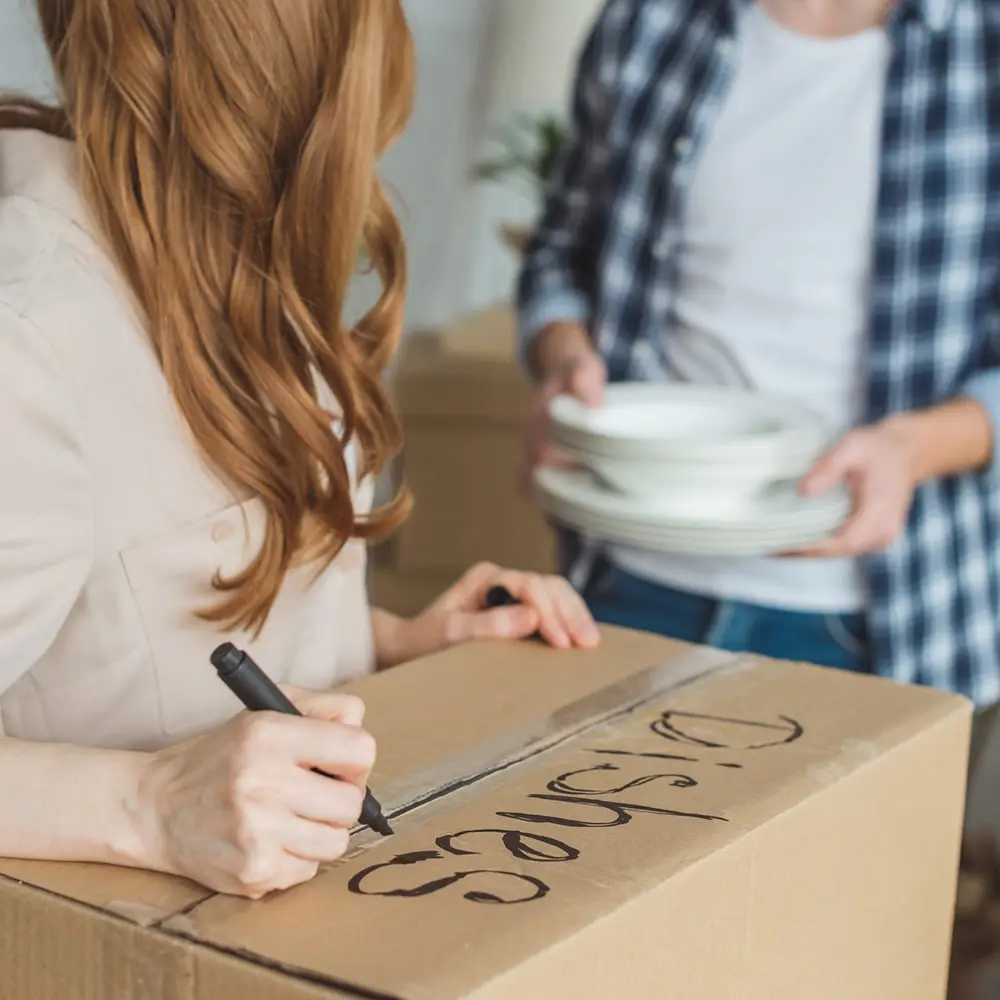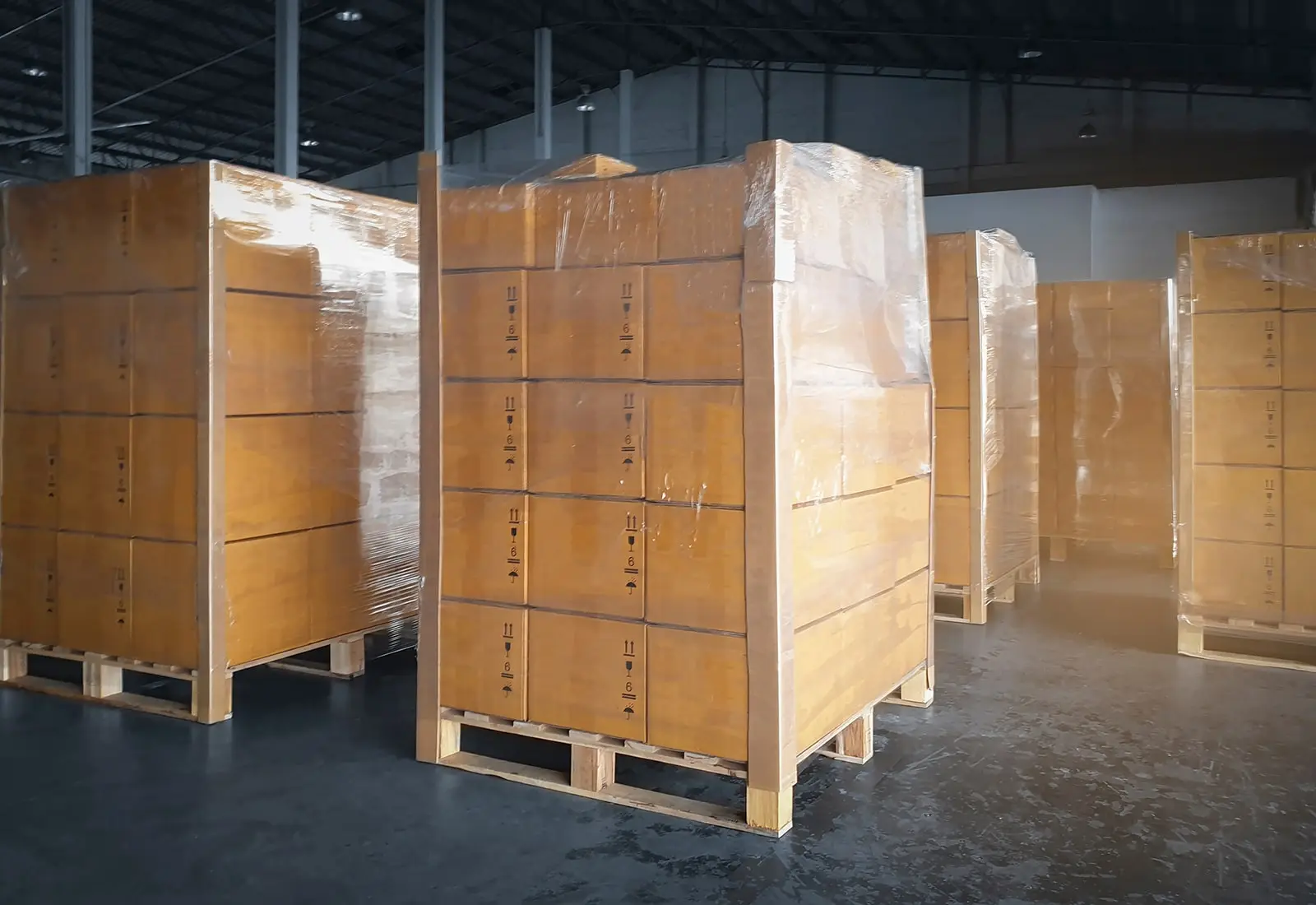Packing moving boxes is a crucial part of the moving process. If not done correctly, your belongings can arrive at your new home damaged and in disarray. To avoid this, it’s important to take the time to properly pack your moving boxes. This guide provides a step-by-step approach to help ensure that your items are protected and arrive in the same condition they left in. From choosing the right boxes to taping them securely, follow these tips to have a successful and stress-free move..
Choose the right box
Choosing the right box type is crucial to ensure your belongings are protected during the move. There are different types of boxes to choose from, so it’s important to understand the different options and choose the right one for your needs.
Corrugated boxes
Corrugated boxes are the most popular type of box for moving. These boxes are made of heavy-duty cardboard and are designed specifically for moving. They are strong and durable, which makes them ideal for protecting your belongings during the move. Corrugated boxes come in a variety of sizes, so you can choose the size that is right for your needs.
Dish barrels
Dish barrels are another option for packing dishes and other fragile items. These boxes are specifically designed for this purpose and are lined with foam to provide extra protection. Dish barrels are also stackable, which makes them a convenient choice for packing multiple items.
Wardrobe boxes
Wardrobe boxes are ideal for packing your clothes and other items that need to stay hanging. These boxes are equipped with a bar that allows you to hang your clothes, so they don’t get wrinkled during the move. Wardrobe boxes are also larger in size, which makes them perfect for bulky items.
Picture boxes
Picture boxes are specifically designed for fragile items such as artwork, frames, and mirrors. These boxes are reinforced with extra cardboard to provide extra protection and are lined with foam to prevent any damage.
Specialty boxes
Specialty boxes are designed for specific items that require extra protection. For example, there are boxes specifically designed for books, lamps, and televisions. These boxes have extra padding or cushioning to protect these items during the move.
When choosing a specialty box, make sure to select the right size and type for the specific item you need to pack. For example, if you are packing a lamp, make sure to choose a box that is large enough to accommodate the lamp and has enough padding to protect it from damage.
Used boxes
Using used boxes is a cost-effective option for moving, but it’s important to consider the condition of the box before using it. If a box is damaged or weakened, it’s not safe to use for moving. Be sure to inspect the boxes for any signs of wear and tear, and if necessary, reinforce them with tape before packing your items.
When using used boxes, make sure to label them clearly so you can easily identify their contents. This will save you time and stress when you arrive at your new home and need to unpack.
Choosing the right box for your moving needs is important to ensure that your belongings are protected during the move. Consider the type of items you need to pack, their size and weight, and choose the right box for your needs. Whether you choose new or used boxes, make sure they are in good condition and labeled clearly.
Gather the right materials
In order to pack your belongings safely and efficiently, you will need to gather the right materials. This includes boxes, packing tape, bubble wrap, paper, markers, and other materials as needed.
Boxes
As mentioned earlier, choosing the right box type is crucial for a successful move. Make sure to use boxes that are sturdy and of a size that is appropriate for your belongings. If you have delicate items, such as glassware or electronics, consider using double-walled boxes for added protection.
Packing Tape
Packing tape is essential for securing your boxes and preventing them from falling apart during the move. Make sure to use high-quality tape specifically designed for packing and moving.
Tape Dispensers
A tape dispenser can make the packing process much easier and more efficient. Tape dispensers allow you to quickly and easily apply tape to boxes without having to stop and search for the end of the tape. Having a tape dispenser on hand will save you time and make the packing process smoother and more enjoyable.
There are several types of tape dispensers available, including handheld dispensers, table-top dispensers, and wall-mounted dispensers. Consider which type of dispenser will work best for you, and make sure to have one handy for the packing process.
Bubble wrap
Bubble wrap is a great material for protecting delicate items during the move. Wrap each item in bubble wrap and place it in the box, making sure to fill any empty spaces with additional bubble wrap to prevent items from shifting during the move.
Paper
Paper is great for filling empty spaces in boxes and cushioning delicate items. You can use newspaper, packing paper, or even old clothing to protect your items during the move.
Markers
A permanent marker is essential for labeling your boxes, as mentioned earlier. Make sure to choose a marker that is easy to read and won’t smudge or fade during the move.
Specialty Boxes
In addition to regular boxes, there may be specialty boxes that you need for specific items. For example, if you are moving books, you may want to use a small book box that is specifically designed to protect and store books. If you are moving items such as lamps or vases, you may need a box with dividers to prevent these items from breaking.
Box Cutters
Box cutters are an essential tool for cutting boxes and opening boxes at your new home. Make sure to have a box cutter handy and take extra care when cutting boxes to avoid any accidents.
Recyclable materials
Whenever possible, try to use recyclable materials for packing. For example, use old newspapers or paper instead of bubble wrap, or use reusable boxes instead of disposable boxes. This not only helps the environment but can also save you money on packing materials.
Packing List
Having a packing list can be extremely helpful during the moving process. Write down what items you need to pack, what materials you need to gather, and any other important information you want to remember. This will help you stay organized and ensure you have everything you need to pack your belongings safely and efficiently.
Label the boxes
Labeling your boxes is an important step in the moving process, as it helps you keep track of your belongings and makes unpacking much easier. When labeling your boxes, make sure to use a clear and legible font, and include important information such as the contents of the box and the room where the box should be placed in your new home.
Label the contents
When labeling the contents of your boxes, be as specific as possible. This will help you quickly and easily find what you need when you arrive at your new home. For example, instead of simply writing “kitchen items,” you could write “kitchen items – mugs, plates, utensils, etc.”
Label the room
Label each box with the room it should be placed in your new home. This will help you and the movers know exactly where to place each box when you arrive. If you have multiple items for the same room, consider grouping these items in the same box and labeling it accordingly.
Label fragile items
If you have fragile items in your boxes, make sure to label the boxes as “fragile.” This will help the movers take extra care when handling these boxes and prevent any damage during the move.
Label boxes with special instructions
If you have any special instructions for handling specific boxes, make sure to label these boxes accordingly. For example, if you have a box with delicate items, you could label it “handle with care.”
Color coding
A color coding system can also be an effective way to label your boxes and keep track of your belongings. You can assign a different color to each room in your new home and label the boxes accordingly. This will help you, and the movers easily identify which boxes belong in which room and can also help you unpack more efficiently.
For example, you could use a blue label for the kitchen, a red label for the living room, a green label for the bedroom, and so on. This will make it easy to quickly identify which boxes belong in which room, even if you have multiple boxes for each room.
Label both sides and the top of the box
When labeling your boxes, make sure to label both sides and the top of each box. This will help you easily identify your boxes, even if they are stacked on each other. Writing the labels on the sides of the box will also help the movers quickly identify the contents of each box, even if it’s in a pile of boxes.
Label items inside the box
In addition to labeling the outside of the box, you may also want to label items inside the box. For example, if you are packing a box with multiple items, you could write down a list of the items inside the box and tape it to the inside of the lid. This will help you quickly and easily find what you need when you arrive at your new home.
When labeling items inside the box, make sure to use a permanent marker and write legibly. You may also want to consider taking a photo of the contents of each box for reference in case the labels become smudged or damaged during the move.
Label boxes with important information

If you have items that require special handling, such as delicate items or items that need to be placed in a specific location in your new home, make sure to label the box with this information. This will help the movers take extra care when handling these items and prevent any damage during the move.
Labeling your boxes is an important step in the moving process, and taking the time to properly label each box will make the process much easier and less stressful. Whether you are using a color coding system or simply writing the contents of each box, be sure to label both sides and the top of each box, as well as items inside the box, to ensure that your belongings are properly organized and protected during the move.
Pack heavy items in small boxes
When it comes to packing, it’s important to consider the weight of items as well as the size. Packing heavy items in small boxes is an important step in protecting your belongings during the move.
Avoid Overloading
Overloading boxes with heavy items can lead to damage to the boxes or to your belongings. It’s important to be mindful of the weight of items and to avoid overloading boxes. If a box is too heavy, it can become difficult to carry and may break during the move.
Spread the Weight Evenly
When packing heavy items, it’s important to spread the weight evenly. This helps to prevent the box from becoming lopsided and makes it easier to carry. Place the heavier items in the bottom of the box and fill any empty spaces with lighter items to ensure that the weight is distributed evenly.
Use Small Boxes
Using small boxes for heavy items is important to prevent overloading and to ensure that the boxes are easy to carry. This is especially important for items such as books, kitchen appliances, and tools. Small boxes can help prevent these items from becoming too heavy and make them easier to move and transport.
Consider Box Strength
When packing heavy items, it’s important to consider the strength of the box. Boxes that are not strong enough may break or become damaged during the move, which can result in damage to your belongings. Make sure to choose boxes that are designed to hold heavy items and are made from strong, durable materials.
Use Reinforcement
Reinforcement materials such as packing tape or corner protectors can help to strengthen boxes and protect your belongings during the move. Wrap heavy items in paper or bubble wrap to provide additional cushioning, and use packing tape to reinforce the bottom and sides of boxes.
Label Heavy Boxes
It’s important to label heavy boxes clearly to ensure they are handled with care during the move. Label the boxes with words such as “fragile” or “heavy” to ensure that they are handled properly and not dropped or stacked on top of other boxes.
It’s also important to remember that when packing heavy items, it’s best to have someone help you. Moving heavy boxes can be dangerous and can result in injury.
Taking the time to properly pack heavy items in small boxes is essential to ensure the safety of your belongings during a move. Follow the tips outlined in this article, and you can be confident that your heavy items will arrive at your new home in the same condition they left. Whether you’re moving a few boxes or a whole house full of belongings, packing heavy items the right way is an important step in a successful move.
Use packing peanuts and bubble wrap to protect fragile items
When packing fragile items, it’s important to take extra care to protect them from damage during the move. Packing peanuts and bubble wrap are two materials that can be used to protect fragile items and ensure that they arrive at your new home in the same condition that they left.
Packing Peanuts
Packing peanuts are small foam pieces that are used to fill empty spaces in boxes and provide cushioning for fragile items. When packing fragile items, fill the bottom of the box with packing peanuts, place the item on top, and then fill the remaining spaces with more packing peanuts to ensure that the item is surrounded by cushioning.
Bubble Wrap
Bubble wrap is a flexible material made up of small air-filled bubbles. When wrapping fragile items, place the item in the center of a piece of bubble wrap and wrap the item tightly, making sure to cover all sides. The air-filled bubbles will help to protect the item from bumps and shocks during the move.
Use Both Packing Peanuts and Bubble Wrap
Packing peanuts and bubble wrap can provide extra protection for fragile items during the move. Place the item in the center of a piece of bubble wrap and wrap it tightly. Then, place the wrapped item in a box filled with packing peanuts to ensure that it is surrounded by cushioning.
Other Alternatives
In addition to packing peanuts and bubble wrap, other materials can be used to wrap fragile items during a move. Some alternatives include:
Foam sheets
Foam sheets are similar to bubble wrap, but they are made from a thicker and sturdier material. They can be cut to size and used to wrap fragile items for extra protection.
Newspaper
Newspaper can be used as a cushioning material for fragile items. Simply wrap the item in several layers of newspaper and place it in a box filled with packing peanuts or additional layers of newspaper.
Towels and Blankets
Towels and blankets can be used to wrap fragile items and provide extra cushioning during the move. Simply wrap the item in a towel or blanket and place it in a box.
Clothes and Linens
Clothes and linens can also be used as cushioning material for fragile items. Simply place the item in a box and fill any empty spaces with clothes or linens to provide extra protection.
When wrapping fragile items, it’s important to use enough material to provide a cushion around the item and to fill any empty spaces in the box. This will help to prevent damage to the item during the move.
Several materials can be used to wrap fragile items during a move. Whether you choose packing peanuts, bubble wrap, foam sheets, newspaper, towels and blankets, or clothes and linens, the key is to use enough material to provide a cushion around the item and fill any empty spaces in the box. By doing so, you can protect your fragile items and ensure that they arrive at your new home in the same condition that they left.
Fill empty spaces with newspaper
When packing boxes, it’s important to fill any empty spaces with materials that will help to prevent the contents of the box from shifting during the move. One of the most common materials used for this purpose is newspaper.
Benefits of Using Newspaper
Protection
Newspaper can help to protect fragile items from damage during the move. By filling any empty spaces in the box, newspaper will help to prevent the contents of the box from shifting and potentially damaging delicate items.
Cost-Effective
Newspaper is a cost-effective alternative to other packing materials, making it a great option for those who are moving on a budget.
Easy to Obtain
Newspaper is readily available and can be easily obtained from local newspapers or recycling centers.
Eco-Friendly
Using newspaper as a packing material is an eco-friendly option, as it helps to reduce waste and prevent the use of single-use materials.
How to Use Newspaper
When using newspaper to fill empty spaces in boxes, it’s important to follow these steps:
- Fill the bottom of the box with a layer of newspaper.
- Place fragile items on top of the newspaper, making sure to fill any spaces around the items with more newspaper.
- Fill the remaining spaces in the box with newspaper, making sure to press down firmly on the newspaper to eliminate any empty spaces.
Other Alternatives
While newspaper is a common material used to fill empty spaces in boxes, as we mentioned above, other alternatives can be used, including:
Packing peanuts
Packing peanuts can be used to fill empty spaces in boxes and provide cushioning for fragile items.
Bubble wrap
Bubble wrap can be used to wrap fragile items and provide extra cushioning during the move.
Foam sheets
Foam sheets can be used as an alternative to newspaper, providing a sturdier option for cushioning fragile items.
Tape the boxes securely
Taping the boxes securely is a crucial step in packing for a move. It helps to ensure that the contents of the box remain safe and protected during transportation.
Why Tape the Boxes Securely?
- Protects Contents: By taping the boxes securely, you can prevent the contents of the box from spilling out during the move. This will help to ensure that your items arrive at your new home in the same condition they left.
- Supports the Structure of the Box: Taping the boxes securely also helps to reinforce the structure of the box, making it stronger and less likely to break open during the move.
How to Tape the Boxes Securely
When taping boxes, it’s important to follow these steps to ensure that they are securely sealed:
- Start by taping the bottom of the box. Make sure to overlap the tape by a few inches on each end to provide extra reinforcement.
- Next, tape the sides of the box. Make sure to reinforce the corners by applying extra tape to the edges of the box.
- Finally, tape the top of the box. Again, make sure to overlap the tape by a few inches on each end to provide extra reinforcement.
The Importance of Using Quality Tape

- Using quality tape is important when taping boxes for a move. Cheap, flimsy tape may seem like a good idea at first, but it will not hold up during transportation and could result in the contents of the box spilling out. Invest in good quality tape, such as packing tape or duct tape, to ensure that your boxes are securely sealed.
- In conclusion, taping the boxes securely is a crucial step in packing for a move. By following these steps and using quality tape, you can protect the contents of your boxes and ensure they arrive at your new home in the same condition they left.
Summary
Packing for a move can be a stressful and overwhelming experience, but with the right tools and techniques, it can be made much easier. To ensure a successful move, it’s important to choose the right boxes, label them clearly, gather the right materials, pack heavy items in small boxes, use packing peanuts and bubble wrap to protect fragile items, fill empty spaces with newspaper, and tape the boxes securely.
Following these steps, you can protect your items during transportation and make the move as stress-free as possible. Whether you’re moving to a new home or office, the key to a successful move is preparation and organization. With these tips, you’ll be on your way to a smooth and efficient move in no time!


